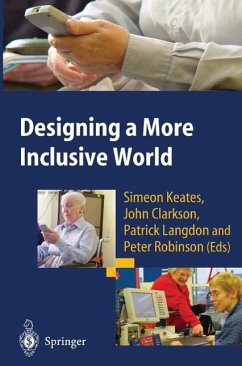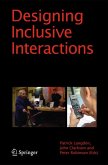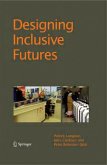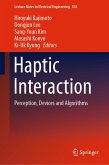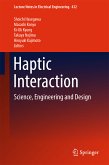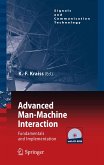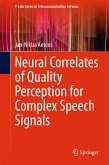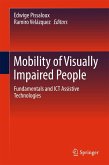Designing a More Inclusive World (eBook, PDF)
Redaktion: Keates, Simeon; Robinson, Peter; Langdon, Patrick; Clarkson, John
160,95 €
160,95 €
inkl. MwSt.
Sofort per Download lieferbar

80 °P sammeln
160,95 €
Als Download kaufen

160,95 €
inkl. MwSt.
Sofort per Download lieferbar

80 °P sammeln
Jetzt verschenken
Alle Infos zum eBook verschenken
160,95 €
inkl. MwSt.
Sofort per Download lieferbar
Alle Infos zum eBook verschenken

80 °P sammeln
Designing a More Inclusive World (eBook, PDF)
Redaktion: Keates, Simeon; Robinson, Peter; Langdon, Patrick; Clarkson, John
- Format: PDF
- Merkliste
- Auf die Merkliste
- Bewerten Bewerten
- Teilen
- Produkt teilen
- Produkterinnerung
- Produkterinnerung

Bitte loggen Sie sich zunächst in Ihr Kundenkonto ein oder registrieren Sie sich bei
bücher.de, um das eBook-Abo tolino select nutzen zu können.
Hier können Sie sich einloggen
Hier können Sie sich einloggen
Sie sind bereits eingeloggt. Klicken Sie auf 2. tolino select Abo, um fortzufahren.

Bitte loggen Sie sich zunächst in Ihr Kundenkonto ein oder registrieren Sie sich bei bücher.de, um das eBook-Abo tolino select nutzen zu können.
Recent legislation in many countries requires the use of technology to enhance the access to everyday facilities for disadvantaged people. This legislation produces a ready made and hungry market for those trained and researching in relevant inclusive technologies.
- Geräte: PC
- ohne Kopierschutz
- eBook Hilfe
- Größe: 27.77MB
Andere Kunden interessierten sich auch für
![Designing Inclusive Interactions (eBook, PDF) Designing Inclusive Interactions (eBook, PDF)]() Designing Inclusive Interactions (eBook, PDF)160,95 €
Designing Inclusive Interactions (eBook, PDF)160,95 €![Designing Inclusive Futures (eBook, PDF) Designing Inclusive Futures (eBook, PDF)]() Designing Inclusive Futures (eBook, PDF)160,95 €
Designing Inclusive Futures (eBook, PDF)160,95 €![Haptic Interaction (eBook, PDF) Haptic Interaction (eBook, PDF)]() Haptic Interaction (eBook, PDF)112,95 €
Haptic Interaction (eBook, PDF)112,95 €![Haptic Interaction (eBook, PDF) Haptic Interaction (eBook, PDF)]() Haptic Interaction (eBook, PDF)167,95 €
Haptic Interaction (eBook, PDF)167,95 €![Advanced Man-Machine Interaction (eBook, PDF) Advanced Man-Machine Interaction (eBook, PDF)]() Advanced Man-Machine Interaction (eBook, PDF)167,95 €
Advanced Man-Machine Interaction (eBook, PDF)167,95 €![Neural Correlates of Quality Perception for Complex Speech Signals (eBook, PDF) Neural Correlates of Quality Perception for Complex Speech Signals (eBook, PDF)]() Jan-Niklas AntonsNeural Correlates of Quality Perception for Complex Speech Signals (eBook, PDF)72,95 €
Jan-Niklas AntonsNeural Correlates of Quality Perception for Complex Speech Signals (eBook, PDF)72,95 €![Mobility of Visually Impaired People (eBook, PDF) Mobility of Visually Impaired People (eBook, PDF)]() Mobility of Visually Impaired People (eBook, PDF)175,95 €
Mobility of Visually Impaired People (eBook, PDF)175,95 €-
-
-
Recent legislation in many countries requires the use of technology to enhance the access to everyday facilities for disadvantaged people. This legislation produces a ready made and hungry market for those trained and researching in relevant inclusive technologies.
Dieser Download kann aus rechtlichen Gründen nur mit Rechnungsadresse in A, B, BG, CY, CZ, D, DK, EW, E, FIN, F, GR, HR, H, IRL, I, LT, L, LR, M, NL, PL, P, R, S, SLO, SK ausgeliefert werden.
Produktdetails
- Produktdetails
- Verlag: Springer London
- Seitenzahl: 268
- Erscheinungstermin: 6. Dezember 2012
- Englisch
- ISBN-13: 9780857293725
- Artikelnr.: 44183865
- Verlag: Springer London
- Seitenzahl: 268
- Erscheinungstermin: 6. Dezember 2012
- Englisch
- ISBN-13: 9780857293725
- Artikelnr.: 44183865
- Herstellerkennzeichnung Die Herstellerinformationen sind derzeit nicht verfügbar.
Simeon Keates, University of Cambridge, UK / John Clarkson, University of Cambridge, UK / Patrick Langdon, University of Cambridge, UK / Peter Robinson, University of Cambridge, UK
I Design Issues for Universal Access and Assistive Technology.- 1. Is Universal Design a Critical Theory?.- 2. Cross-market Product and Service Innovation - the DBA Challenge Example.- 3. Introducing User-Centred Design Methods into Design Education.- 4. Comparing Product Assessment Methods for Inclusive Design.- 5. Virtual Learning Environments: Improving Accessibility Using Profiling.- 6. Assessment, Insight and Awareness in Design for Users with Special Needs.- 7. New Cognitive Capability Scales For Inclusive Product Design.- II Enabling Computer Access and New Technologies.- 8. An AAC-Enabled Internet: From User Requirements to Guidelines.- 9. Gathering Requirements for Mobile Devices Using Focus Groups with Older People.- 10. Devices and Desires: Identifying the Acceptability of AT to Older People.- 11. Beyond Functionality - Product Semantics in Assistive Device Design.- 12. Consensus-based Adaptive User Interface Implementation in Product Promotion.- 13. Transforming Musical Notations for Universal Access.- 14. Evaluation of Multimodal Techniques for Blind People to Track Moving Objects.- 15. Movement Time Prediction for Tasks Assisted by Force-feedback.- 16. Recognising Expression in Speech for Human Computer Interaction.- 17. Emotional Hearing Aid: An Assistive Tool for Children with Asperger's Syndrome.- 18. Fostering Universal Access: Lessons from Telecommunications and Disability.- 19. Assessing the Accessibility of Digital Television Set-Top Boxes.- III Assistive Technology and Rehabilitation Robotics.- 20. Robot Technology in Rehabilitation and Support -State of the Art.- 21. Powered Lower Limb Orthosis for Assisting Standing Up and Sitting Down Movements.- 22. Collaborative Control Aspects for Rehabilitation Robots.- 23. Effects of Repeated Exposureto a Humanoid Robot on Children with Autism.- 24. The Gloucester Smart House for People with Dementia -User-Interface Aspects.- 25. Standards and the Dependability of Electronic Assistive Technology.- 26. If I had a Robot at Home... Peoples' Representation of Domestic Robots.- Index of Contributors.
I Design Issues for Universal Access and Assistive Technology.- 1. Is Universal Design a Critical Theory?.- 2. Cross-market Product and Service Innovation - the DBA Challenge Example.- 3. Introducing User-Centred Design Methods into Design Education.- 4. Comparing Product Assessment Methods for Inclusive Design.- 5. Virtual Learning Environments: Improving Accessibility Using Profiling.- 6. Assessment, Insight and Awareness in Design for Users with Special Needs.- 7. New Cognitive Capability Scales For Inclusive Product Design.- II Enabling Computer Access and New Technologies.- 8. An AAC-Enabled Internet: From User Requirements to Guidelines.- 9. Gathering Requirements for Mobile Devices Using Focus Groups with Older People.- 10. Devices and Desires: Identifying the Acceptability of AT to Older People.- 11. Beyond Functionality - Product Semantics in Assistive Device Design.- 12. Consensus-based Adaptive User Interface Implementation in Product Promotion.- 13. Transforming Musical Notations for Universal Access.- 14. Evaluation of Multimodal Techniques for Blind People to Track Moving Objects.- 15. Movement Time Prediction for Tasks Assisted by Force-feedback.- 16. Recognising Expression in Speech for Human Computer Interaction.- 17. Emotional Hearing Aid: An Assistive Tool for Children with Asperger's Syndrome.- 18. Fostering Universal Access: Lessons from Telecommunications and Disability.- 19. Assessing the Accessibility of Digital Television Set-Top Boxes.- III Assistive Technology and Rehabilitation Robotics.- 20. Robot Technology in Rehabilitation and Support -State of the Art.- 21. Powered Lower Limb Orthosis for Assisting Standing Up and Sitting Down Movements.- 22. Collaborative Control Aspects for Rehabilitation Robots.- 23. Effects of Repeated Exposureto a Humanoid Robot on Children with Autism.- 24. The Gloucester Smart House for People with Dementia -User-Interface Aspects.- 25. Standards and the Dependability of Electronic Assistive Technology.- 26. If I had a Robot at Home... Peoples' Representation of Domestic Robots.- Index of Contributors.
